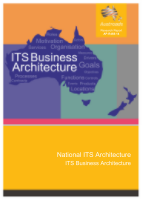Traffic Management

- Publication no: AP-R468-14
- ISBN: 978-1-925037-82-1
- Published: 11 November 2014
- PDF (free) Download
A key initial step in the development of the National ITS Architecture for Australia is to build the conceptual ITS Business Architecture platform on which subsequent and more detailed architectural models can be built.
The ITS Business Architecture is often considered a reference architecture. The proposed ITS Business Architecture described in this report is intended to allow transport agencies and ITS–related organisations to describe and develop ITS solutions using a consistent approach and terminology. Subsequent projects will define the ITS Information Systems Architecture models.
This report outlines the business and organisational context for ITS in Australia, and the reference or conceptual models providing a high level view of ITS business processes/functions and services.
The proposed Australian National ITS Architecture is intended to allow transport agencies and ITS–related organisations describe and develop ITS solutions using a consistent terminology and content.
This document should be read with the Austroads report National IT Architecture: Context and Vision(AP-R467-14).
- Summary
- Architecture Vision Alignment
- The Business Context (Motivation)
- The Organisational Context (Organisation)
- ITS Business Functions (Function)
- ITS Services (Function)
- Future Work
- 1. Introduction
- 1.1. Purpose
- 1.2. Scope
- 1.2.1. . NS1696 - Stage 1
- 1.2.2. . Future Project Stages
- 2. Methodology
- 2.1. Overview
- 2.2. Approach
- 2.3. Meta-Model Alignment
- 3. ITS Architecture Vision Alignment
- 4. ITS Architecture Context
- 5. ITS Business Context (Motivation)
- 5.1. ITS Drivers
- 5.2. ITS Goals and Objectives
- 5.3. ITS Constraints
- 5.4. ITS Key Performance Indicators
- 6. ITS Organisational Context (Organisation)
- 6.1. ITS Organisations
- 6.2. ITS Actors
- 6.2.1. . Example: ITS Terminator: Driver
- 7. ITS Services
- 7.1. Summary of Service Groups and Categories
- 7.1.1. . Example: ITS Service Category 7.2.1 – Emergency Services
- 8. ITS Business Functions
- 8.1. Summary of ITS Business Functions
- 8.2. Example: ITS Function 2.1.9 – Provide Emergency Operator Interface
- 8.2.1. . Functional Area 2. Provide Safety and Emergency Facilities
- 8.2.2. . High Level Function 2.1 Manage Emergencies
- 8.2.3. . Low Level Function 2.1.9 Provide Emergency Operator Interface
- 9. Next Steps
- References
- Glossary
